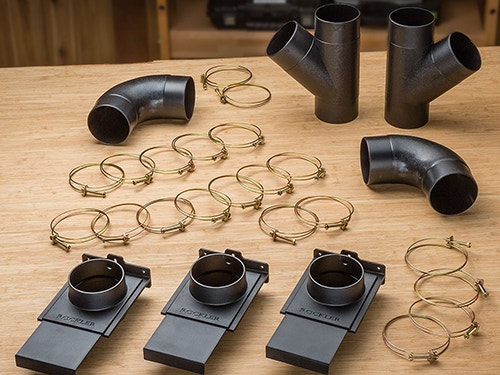Dust Collection System Design and Equipment
Below, we'll help you get the right dust collection fittings, ducting, ports and other dust collection equipment designed to help you get the most out of your dust collection system.
We also recommend more in-depth research. There are a number of excellent dust collection books available. Many of these books have detailed information on best practices in dust collection and instructions on designing a system that will take all of the guesswork out of getting set up.
Dust Collection System Equipment and Design Tips
Use rigid metal pipe and metal fittings for longer runs of ductwork. Air travels smoothly through rigid spiral pipe, reducing the static pressure losses in the system and increasing the system's efficiency. Metal fittings designed to reduce friction in air handling systems greatly increase the efficiency of central dust collection systems.
Use flexible hose designed for dust collection. Using flexible hose that's not designed for the dust collection can greatly reduce the efficiency of the system. FlexiPort dust collection hose is designed to produce a minimum amount of static pressure loss and to stand up to the vacuum pressures produced in dust collection. Clear, wire reinforced dust collection hose has the added benefit of making clogs and buildups of debris in the system easy to spot and correct.
Isolate each woodworking machine in the system with a blast gate. In most cases, to achieve adequate dust collection at individual machines, you will need to use either automatic or manual blast gates to shut off the air flow to other machines that are not in use.
Automatic blast gate systems are an extremely convenient solution. They open the correct blast gate and turn on the dust collection system when you flip the power tool's switch. An added feature of automatic systems is that they prevent you from forgetting to turn on the system and open the correct gate.
For a more budget economical solution, manual blast gates will work perfectly well. Rockler offers plastic blast gates designed for use with flexible hose and PVC fittings and metal blast gates that can be used with either flexible hose or metal pipe.
Outfit you tools with dust collection ports, hoods. The dust collection performance for many open stand table saws and jointers can be greatly improved with the installation of a dust collection hood. The hoods can be easily adapted to fit most contractor-type table saws and 6' and 8' jointers and are designed to work with 4' dust collection hose. For router tables, use the universal dust port. The universal dust port's flange attaches with screws and can be used with 2-1/2' dust collection hose or 2' shop evac hose.
Use universal ports for tools with no direct dust collection port. For tools with no direct dust collection attachment, or to enhance primary dust collection, use a top dust fitting or a free-standing universal dust collection port.
Use quick release connectors. If you are setting up a portable dust collection system, quick release connectors such as keyed hose clamps and quick disconnect dust collection fittings will make moving your dust collector from machine to machine quick and easy. For stationary systems, they will make set-up, cleaning and inspection much less time consuming.
Use the right size of reducer or adapter to step down hose diameter. In general, it is better to use large diameter hose for longer runs and step down to the correct size for machinery dust ports as close to the machine as possible. Using the wrong-sized or makeshift adapters to step down hose diameter creates unnecessary drag on the system. Reducers designed for use with dust collection hose make transitions between hose diameters as smooth as possible. A universal duct adapter allows transitions between any combination of the most common hose diameters. The dust collection hose adapter allows 4' hose to be connected to most standard 2-1/4' bench top tool dust ports.
Ground your dust collection system's ductwork. Static electricity build-up in your system's ductwork presents a fire hazard and can produce an electric shock on contact. When properly installed, a dust grounding kit will greatly reduce the static electricity build-up in your system's ductwork.
Increase your system's chip holding capacity with a dust collection separator. Dust collection separators increase the waste holding capacity of your dust collection system by separating out larger sized chips and shavings before they reach your dust collector. They also reduce wear on your dust collector's blower assembly caused by collisions with large debris particles.
Keep the inspiration coming!
Subscribe to our newsletter for more woodworking tips and tricks


